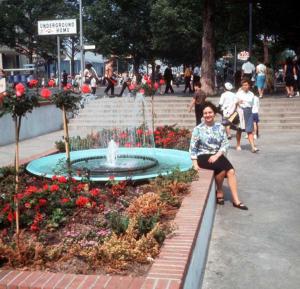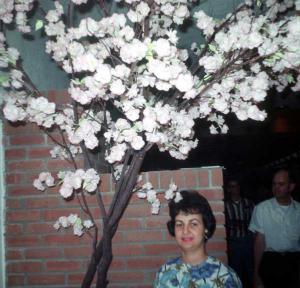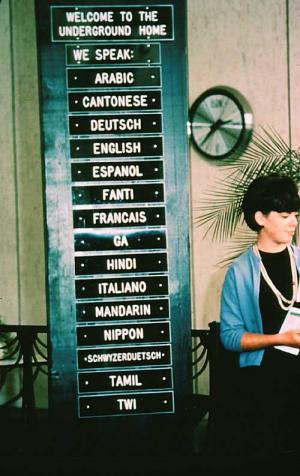|
In many ways, the 1964-65 New York World’s
Fair was a collection of architectural wonders. Everywhere you
looked there was some strange new shape to attract the eyes –
the immense size of the Unisphere, perhaps, or the arching wall
at General Motors, the moonscape roof at Kodak or the cantilevered
Bell System pavilion. Of all of the unusual structures at the
Fair, however, maybe none was stranger than an exhibit marked
by several bland little buildings. Located just across the Avenue
of the United Nations from the United States Space Park and the
Hall of Science, these buildings marked the entrance to an exhibit
that was truly one of a kind.
A small garden and fountain
upstairs gave no hint of what was hidden three feet below.
SOURCE: All photographs,
Courtesy Bill Cotter Collection unless otherwise noted
 |
This was the Underground World Home. As
the name implies, it was truly underground, making it one of
the least seen exhibits at the Fair. Not only couldn't you see
it just by walking by, but there was an admission charge to tour
the home and it couldn't handle large crowds. As a result, most
Fair visitors just passed it by without a second thought. If
they had taken the time to go downstairs for a look, they would
have found a complete home, furnished and ready for occupants.
How this house buried in the Earth came
to be has its beginnings in the nervousness and paranoia of the
Cold War. In the late 1950s, the city of Plainview, Texas asked
for bids on a prototype bomb shelter, intending to develop an
affordable way for its citizens to survive a nuclear blast. The
contract was won by Jay Swayze, a local builder, who went on
to construct an austere 6 foot x 8 foot bunker designed to house
six inhabitants until it was safe to return to the surface.
Swayze later said that he was intrigued
by the possibilities afforded by subterranean housing, but that
he was convinced people would only move underground if they could
live in relative comfort and style. He tested his theory in grand
style by building a new home for his family – one far larger
than the 48 square foot bomb shelter. When completed, his new
home, also in (or more accurately, under) Plainview, was 2,800
square feet in size. Swayze moved his wife and two daughters
into the 10 room house, then set out with his brother Kenneth
to convince the rest of the world that they wanted to live under
three feet of dirt.
As can be imagined, this was a tough sell
and the hoped for flood of orders failed to materialize. The
high cost of underground construction limited sales to wealthy
individuals such as Jerry Henderson, the founder of Avon Cosmetics,
who commissioned homes outside Boulder, Colorado and Las Vegas.
Undaunted at the overall lack of success, Swayze theorized that
if he could only show people the merits of his concept they would
order enough houses to lower the overall construction costs.
Like many other entrepreneurs, Swayze looked
at the Fair as an opportunity to showcase his brainchild to the
millions of expected visitors who would soon be flooding through
Flushing Meadows. After securing the financing from Jerry Henderson,
he successfully built his Underground World Home. While the living
area in this version was smaller than his home back in Texas,
the overall project was larger, for it had bigger underground
"gardens" and a terrace. The Fair version also incorporated
several design improvements, including pier and beam construction
and wood floors. For fun, Swayze included an organ, an idea he
freely noted he had borrowed from Carlsbad Caverns.
The Underground World Home was built exactly
like the homes Swayze was hoping to sell, with a concrete shell
enclosing a 5,600 square foot area. The roof and floor was 10"
thick, with 13" walls. A particular construction challenge
was the marshy soil at the Flushing Meadow site, for it required
additional waterproofing protection and bracing. In fact, the
souvenir book available at the Fair described the site as "a
Long Island swamp!"
What did visitors to the Underground Home
see? Before descending into the home itself there was a display
about the construction techniques used and the benefits of living
underground. Then it was downstairs, where tour guides took visitors
for a tour of the three-bedroom home. After looking around at
the house and terrace, visitors then climbed back upstairs where
they could buy a booklet with more information on how they could
arrange for their own subterranean chalet.
A combination of fake and real
plants helped create the illusion that you were still above ground.
 |
Was the Fair successful in promoting Swayze’s
vision? It's hard to say, for stated attendance numbers are misleading.
The 1965 version of the booklet sold at the Fair states that
516,000 visitors toured the exhibit the prior year, yet after
the Fair Swayze claimed that more than 1,600,000 people had visited
the Underground Home. It certainly is unlikely that more than
a million people toured the home in the second season. In any
event, the downturn of fears about nuclear war led to less interest
in the concept, and Swayze eventually sold his Plainview home
and moved to Hereford, Texas. There he and his brother formed
Geobuilding Systems, which was intended to revive awareness of
underground homes. In 1980 Jay Swayze wrote a book extolling
the virtues of buried housing, but he only mentioned the Fair
in passing. Recent searches on the Internet failed to turn up
further news of Swayze or Geobuilding Systems.
Tours of the Underground World
Home were available in an astonishing 15 different languages.
SOURCE: Photo United
Airlines Presents Slide Show courtesy Bradd Schiffman Collection
 |
Finally, what became of the Underground
World Home when the Fair closed? Was it destroyed or just left
in place, sitting silently awaiting for someone to unearth it
again? So far, no definitive word has been found as to what happened
after the end of the Fair. Considering the cost that would have
been incurred to rip a structure of this size out of the ground,
and the lack of any real motivation to do so, it's highly likely
that the exhibitors simply pulled down the surface structures,
emptied out the contents of the house and headed back home. If
this was the case the building is probably flooded, but it could
be a World’s Fair legacy yet to be seen again.
Swayze’s book, by the way, is titled
"Underground Gardens and Homes: The Best of Two Worlds,
Above and Below". It can be found in many large libraries
and occasionally at used book stores.
|